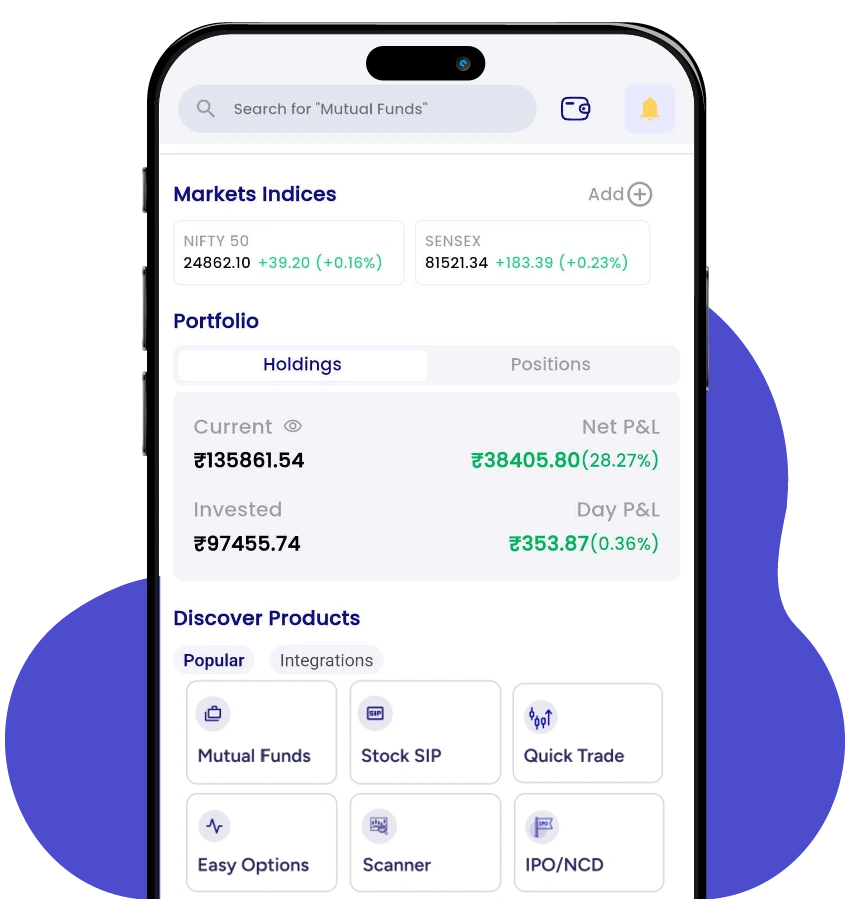What is a Put Option?
- 18th July 2025
- 10:30 AM
- 7 min read
Heard of put options, but are still unsure how they actually work? A put option is a smart tool that lets you profit when the stock market falls. It gives you the right to sell a stock at a fixed price, helping protect your investments during downturns.
Whether you’re hedging risks or speculating on a decline, understanding puts can give you an edge. This blog explains what is put option in stock market and the appropriate time to buy or sell it.
What Does Put Option Mean?
A put option gives you the right, but not the obligation, to sell a security at a predetermined price, known as the strike price, any time before the option expires. Put options can be used on various assets like stocks, commodities, or currencies, often as a strategy to hedge against falling prices.
If you are selling a put option, you are obligated to buy the security at the strike price if the buyer chooses to exercise the option.
3 Essential Features of Put Options
-
Expiration Date
An options contract has an expiry date by which you must exercise the contract. In India, options contracts typically expire on the last Thursday of each month.
-
Premium
You must pay a premium amount to the options seller, which is considered the price of an options contract. This premium is non-refundable regardless of whether the option is exercised or it expires worthless.
-
Strike Price
A strike price is a predetermined price, which is crucial for an option’s profitability.
How Do Put Options Function?
A put option can be used either as a tool for speculation or as a hedge against a potential decline in an asset’s price. Let us understand how a put option works with an example.
Suppose you expect the price of a stock to fall. The current market price of the stock is INR 1,000, and you believe it will drop. So, you buy a put option with a strike price of INR 800 by entering into a contract with another trader.
Scenario 1
If the stock price goes down to INR 700 on the expiration date, you can exercise your right to sell the security at your predetermined price of INR 800. You get a profit of INR 100.
Scenario 2
If it comes to INR 900, then you can refrain from exercising your right to sell. The seller will receive a premium that you have paid.
Advantages of Put Options
Since you know the features of put options and how they work, knowing its benefits is also crucial. Here are some advantages of a put option:
- You might profit while buying a put option if the underlying asset’s price slightly declines or even remains the same.
- Options always give sellers an advantage, as they become less valuable at the end of the stated duration. Hence, put option sellers are more likely to gain from time decay by selling the contract while it is still valuable.
- Put options can be purchased with lower capital, as you only have to pay for the right.
- Put options are useful in hedging your long positions.
Why wait any longer to trade via put option? Use the PL Capital Group – Prabhudas Lilladher application to open a trading account to trade in put options.
When Should You Buy a Put Option?
Buying a put option requires limited capital—but timing is everything. Many F&O traders suffer losses simply because they do not know when to act. In fact, between FY22 and FY24, a staggering 93% of individual traders lost money in futures and options trading.
This highlights a critical need: understanding the right time to buy a put option can make all the difference between profit and loss. When you buy a put option, your maximum loss is limited to the premium paid; nothing more.
It is a smart way to protect your investments. You should consider buying a put option when you expect the price of a security to fall. If it does, you can sell it at the higher, predetermined strike price and avoid losses.
For instance, you have purchased a put option on a stock expiring after 3 months at a strike price of INR 100 per share, believing the price will decline. You have paid INR 300 as a premium. Now this can again lead to two possible scenarios:
- If the stock price decreases to INR 80, you can use your put option to sell it at INR 100, making a profit of INR 20 per share, while deducting the premium of INR 300.
- If the stock price stays above INR 100, you lose your INR 300 investment.
Hence, the right time to buy put options is when you believe the stock price will go down.
When Should You Sell a Put Option?
Since you know when you should buy put options, you must know the right time or situation to sell them. Selling a put option can help you earn the premium paid by buyers. After selling it, you, as a put seller, must purchase the asset at the strike price if its price remains the same or rises above the strike price.
You must sell a put option when you believe the price will not drop below the strike price before the expiry date. This helps you to keep the premium paid by the buyer.
If the asset’s price goes below the strike price, the buyer will exercise his right to sell the asset. You must sell a put option at a time to keep the premium paid by buyers.
Final Thoughts
A put option can be purchased with lower capital and is useful in hedging your long positions. Put options help traders make additional profit and recover losses. Based on risk tolerance and market conditions, you can choose between a put and a call option.
Want to know more about the put option? Download the PL Capital application and open a trading account for free. With 80+ years of experience, PL Capital enables you to use its derivatives trading facilities and earn the highest returns.
Frequently Asked Questions
1. Which is better: a put option or a call option?
Opting for a better strategy between a put or a call option depends on various factors. This includes your risk tolerance, market conditions, and long-term investment goals.
2. Can I lose the total amount of paid premium for my put option?
Yes, you can lose the total amount of premium you have paid for your put. This can happen if the underlying security’s price does not go below the strike price before the expiration date.
3. Who gets advantages from a put option?
The put option buyer gets the advantage when the price of the underlying asset goes below the strike price.
4. What do you mean by nifty call and put?
In options trading, Nifty call and put options provide the buyer the right but not the obligation to trade the Nifty 50 index at a predetermined price.





